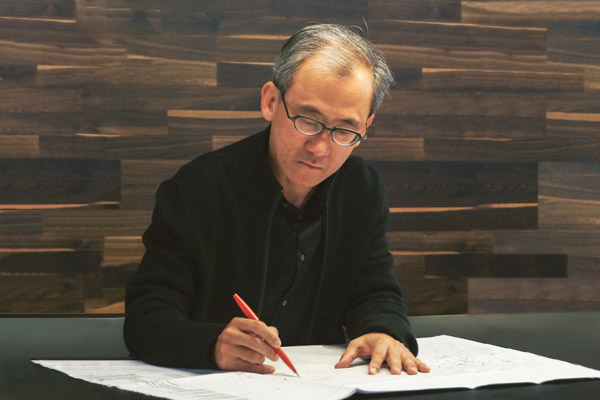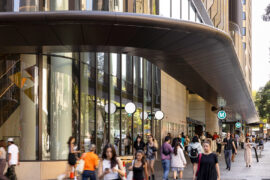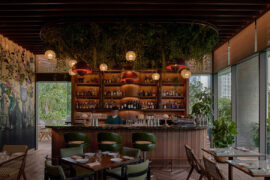With a philosophical take on architecture, this year’s President’s Design Award “Designer of the Year” Tan Kok Hiang looks back on a practice spanning decades, and recalls exceptional moments of encounter and beauty that fuel the emotional aspect of his calling. Stephanie Peh sits down with the Principal Director of Forum Architects for this interview.

December 3rd, 2014
Top image: Almukminin Mosque

Tan Kok Hiang, Principal Director of Forum Architects
Can you share with us your journey as an architect?
I knew I wanted to become an architect at the age of 14. I made boxes out of cardboards which I had collected. I would pay attention to the joints, texture and difference between the interior and exterior, studying how the boxes can be opened and closed. As I grew older, I became interested in actual buildings, and would study books extensively.
Looking back, events in my life have made me think that I was meant to do architecture. In my teens, one of my favourite buildings was the Yale Art and Architecture Building, also known as the Rudolph Hall, designed by Paul Rudolph. I looked for pictures of it everywhere (there was no internet in those days). It fascinated me. Thirty years later, on a work trip to Yale – I was working on the Yale Campus in Singapore – I walked into the Rudolph Hall one evening, just before it closed. I was overwhelmed by a feeling of ‘coming home’, as if I had known the building all my life.
Designing the Assyafaah Mosque was another strange one. In architecture school, my final year thesis was about Islamic architecture. I researched extensively about the meaning and drives behind Islamic architecture. Thirteen years later, I got the opportunity to put everything I learnt in practice. I took part in the design competition for the Assyafaah Mosque and won. It was based on using the arabesque as the essential representation of Islam in the building. I had also bravely dismissed the dome as irrelevant to both the Malay and Muslim culture of Singapore.

(Left) Assyafaah Mosque; (Right) Manila Chancery
At which stage of your creative process do you often feel emotional?
All of it. I remember my first emotional experience. It was seeing three columns and a slab being cast. The three columns immediately conveyed a sense of space and I remember thinking ‘this wasn’t the size of space I drew’. But of course, it was. My training did not allow me the visual accuracy to imagine what I drew. I became disturbed by this and over the years, mindfully trained myself to imagine what I drew, accurately. I dare say I am pretty accurate now in visualising the scale of buildings, although I have yet to test it on an urban level.
I have always embraced the Lamp of Sacrifice and the Lamp of Beauty, although not in the same religious terms that Ruskin first conceived of them. Without love for craft and beauty, architects might as well not exist. Have you ever wondered why Beauty is so important? Beauty gives you relief from negativity. The key here is that architects take on a big role because we build things that people see. Our role is to be the guardian of the built environment.
Your conscious approach alludes to Japanese morals. Do you agree with that?
I believe we should go through life conscious of what we do. How does one keep calm in a world full of turmoil, especially in architecture, where you meet over twenty consultants at a time? The only secret is that you are mindful of things.
It struck me one day [during a soul-searching trip] that there was something else I was meant to do with my practice. Something bigger. One of the largest meaning of ‘practice’ is that I have people here: staff who work with me, and the people who come through – I call these ‘holy encounters’. Sometimes they leave but for some reason they always come back and I like that. We tend not to think about it, but these ‘holy encounters’ are not accidents. It [the practice] is about the people. The work was a common thing, a medium that needed perfection to work.
What about the changes you have noticed in Singapore, architecturally, over the years?
I used to begrudge the conservativeness of architecture in Singapore, thinking we weren’t courageous enough to try new ideas and forms. Then I looked at other countries, which had been ahead of the curve and maybe gone overboard. Consequently, their architecture have sometimes become wasteful and supercilious, if I can use this word to describe architecture. Singapore’s pace, on the other hand, has been measured and always in consideration of careful use of resources and technology. There has been extensive emphasis on urban planning and less desire for icons. It has not been a whole lot of fun for architects but I think we may need to stay this course for a while.
Tan Kok Hiang / Forum Architects
forum-architects.com
INDESIGN is on instagram
Follow @indesignlive
A searchable and comprehensive guide for specifying leading products and their suppliers
Keep up to date with the latest and greatest from our industry BFF's!

Welcomed to the Australian design scene in 2024, Kokuyo is set to redefine collaboration, bringing its unique blend of colour and function to individuals and corporations, designed to be used Any Way!
The new range features slabs with warm, earthy palettes that lend a sense of organic luxury to every space.

For Aidan Mawhinney, the secret ingredient to Living Edge’s success “comes down to people, product and place.” As the brand celebrates a significant 25-year milestone, it’s that commitment to authentic, sustainable design – and the people behind it all – that continues to anchor its legacy.

London-based design duo Raw Edges have joined forces with Established & Sons and Tongue & Groove to introduce Wall to Wall – a hand-stained, “living collection” that transforms parquet flooring into a canvas of colour, pattern, and possibility.
The internet never sleeps! Here's the stuff you might have missed

‘Civic Vision | Foster + Partners’ is the first comprehensive exhibition of the practice’s work to be held in Australia, providing an in-depth look at its global portfolio of work since it was founded in 1967 by Norman Foster.

Grounded by the rich warmth of American white oak, The Standard’s newly opened restaurant, Kaya, redefines the classic dining convention through a tasteful fusion of biophilic design, mid-century modern sensibility and elevated whimsy.